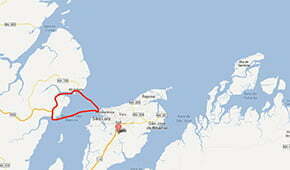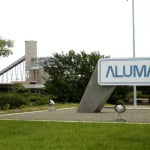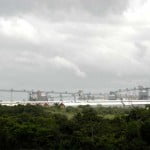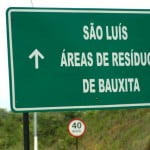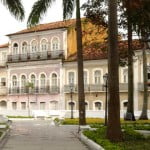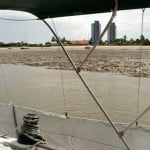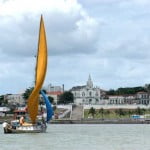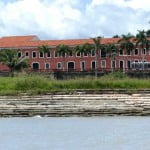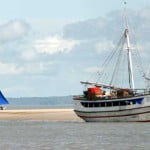Monday, 16 – 05 – 2005
We arrived from São Paulo at 2 p.m. and for this stage of our journey the only members of the crew were Paulina, film maker Paulo Cezar Cardoso and I.
Our goal was to shoot two programs. One showing São Marco Bay and the surroundings where São Luis was built and the other showing Alcântara which is 10 miles away.
However, as usual, before starting the trip, supplying the boat with food and other items is necessary.
We left our luggage in the Endless Sea which was anchored in front of the Yacht Club and went to the supermarket. This is a very boring thing to do, it is always the same, it takes hours, to take to the boat all the packages with food, many bottles of water, of soft drinks as well as other countless items.
This time was not different. It was even harder because there is no pier at the Yacht Club. When we got back with two cabs full of packages there was low tide (see pictures) and here in Maranhão tides are harsh. The waters go up and down and vary from 4 to 6 meters high, sometimes more. Therefore, we had to take our supplies to the beach, walk along 200 meters where it was deep enough for Alonso to take us back to the boat in the rubber boat.
To take all the supplies to the boat, each of us had to go and return at least three times, carrying all those heavy things. In short, at 9:30 p.m., we were putting the last supplies in their compartments in the boat. We were exhausted because of the trip and all that hard work, we slept right after that.
Tuesday, 17 – 05 – 2005
We got up at 7 a.m. We had breakfast and waited for the O Imparcial reporters, people from a local newspaper who wanted to interview us (see – News from the Project – on the site menu).
While we were waiting and during the interview, we were able to see one of the boats maneuver. It is one of the most beautiful boats of the Brazilian coast, the Cuter, also known as Maranhão’s coastal canoe (see pictures).
These boats whose building technique has been transmitted from father to son for centuries are still being used in this area. Two types of sails are used, that of the prow, smaller, known as bujarrona, or stay sail, and the bigger one, carangueja, or big. Both are dyed with strong color dyes, in blue, red, yellow, etc.
Hulls are also painted in different colors giving to the whole a peculiar aspect of very good taste. They are rough boats without motors or any kind of instruments, not even a compass. They only have navigation lights that are used at night.
Our sailboat is anchored in a special place. It seems the wind turns right here where we are, so when they enter São Luis, cutters have to tack (to zigzag) in front of us. They come from afar, from the bay with the prow towards us and when they are right in front of us, they start to turn, sometimes to the right, sometimes to the left, never farther than 10 meters away from our boat. I can assure you I have never had breakfast with such magnificent scenery.
And all this innate nautical skill results from several facts. Here are some of the most important ones:
– the native technique
– the Portuguese maritime art, the world’s most powerful maritime nation during the maritime epic period, bringing from the trips not only spices but also nautical secrets and solutions for problems they had experienced coming from the Indian Ocean, the Persian Golf, India, from the Chinese and Japanese, from people of the Pacific, etc.
– the strong African touch
– the Dutch colonization, the French attempts, the permanent contact with Spanish and English ships,
– the huge extension of our coast, from 4 degrees of northern latitude to 32 degrees of southern latitude, with all sorts of climate, winds and the coastal relief.
Besides these aspects, there is the historical fact that during the first two hundred years after the discovery, the colonizer stopped at the shore and didn’t go too far into the country. During this period, communication, trade, defense activities such as help services, depended exclusively on boats.
These are some of the factors that made us into a maritime nation, therefore, we build a variety of boats for different types of utilization and climate. When we compare to other boats, the main difference their craftmanship. Old building techniques are followed and consequently their original design is maintained. These are the reasons why they are part of our artistic inheritance.
But among the 17 Brazilian coastal states, Maranhão has the greatest variety and probably the greatest amount of such boats.
This can be explained by the fact that this state has three thousand kilometers of navigable rivers. Additionally, Maranhão has the second largest coast in Brazil, that is 640 kilometers along the Atlantic ocean, and Bahia is the first. But only this aspect can not explain all this variety. The reason is found in the form of this coastal zone: in the north, there are the hollows (Reentrâncias Maranhenses), in the south, the dunes, in Barreirinhas, as well as the delta of the Parnaíba river, at the border of Piauí. All of them are flooded areas with cities, small towns, villages having just a few bad roads, sometimes impassable, thus the boats are the true communication means, like in colonial times.
No matter how, for cargo, passengers or fishing transportation purposes, boats are the main characters here, as a transportation means as well as a survival means for a significant part of the population.
That is why wondering on this shore or being anchored in the Bay of São Marcos shows us an extremely beautiful scenery which must be seen and known by all the Brazilian people.
After the breakfast show, I decided to rent a coastal canoe to shoot and register “also from the inside” the art from those who perform the daily show. We chose Flor de Natal (Christmas flower), a beautiful coastal canoe (see pictures) with which we navigated in the bay and passed by the Historical Center of São Luis, under the José Sarney bridge, through the Anil river until Camboa’s pier where these canoes are anchored.
It was amazing. We interviewed three crew members. We had to drop anchor because of a rainstorm. We went to the hold of the boat where we talked for a while, then we continued our journey making curves here and there until the last stop.
We won the day. Late in the afternoon, when it was getting dark, we went back to the Endless Sea.
After diner, we saw on TV the material we had recorded, made a pre-edition, and were amazed at the beauty of the images. The crew of the Endless Sea went to bed while I reported the day we had had at the plotting table with the computer turned on.
It is late now, 3:40 a.m., it is time to go to bed. Tomorrow, as soon as the tide is high enough, we will go to Alcântara.
Wednesday, 18 – 05 – 2005
The tide is lazy today, it was high at around 11 a.m. We had to wait, it was impossible to fight against nature. But as soon as it stretched, we lifted the anchor and put out from our shelter in front of São Luis’ Yacht Club.
On our way, we saw several cutters that were sailing along São Marcos bay. Their design is extremely beautiful, they are seen just as a black silhouette, like a shadow due to the effects of light. In spite of being distracted by the shape of the cutters, the sky was cloudy, gray and obviously it was going to rain heavily. So when we were in the middle of the canal that leads to São Marcos bay (we had to cross it to arrive at Alcântara) the rain was so heavy that a few minutes later we could hardly see beyond the prow.
Sailing only with the help of instruments, in the middle of a busy and low bay, with which you are not familiar, it is not pleasant. But we had no choice. I slowed down the rotation of the motor by diminishing the gear until the sky was clear again. Meanwhile, I was staring at the radar waiting for the sky to be clear and see our way ahead of us as well as the contour of the coast. When that happened we were able to see Alcântara. It was a marvelous scene. From the sea we could see the shape of the Carmelites’ church from the 18th century at the top of the hill. We sailed for half a mile and arrived at the mouth of the Jerijó canal where “Porto Jacaré” is, in fact it is a floating iron platform, a type of anchorage that leads to the town.
This low harbor is quite busy. Many big boats made of iron or wood carry not only passengers and cargo from São Luis but also engineers, technicians and officers from the Launching Base of the air force. We decided to leave the mouth of the canal to anchor in a deeper place.
Before the whole thing ended, it got dark again, announcing that rain was coming again. Therefore, we decided to land later on. Then, I read a little bit more about the city and the surroundings. Alcântara was founded in 1648 and it was Maranhão aristocrats and land owners’ favorite place. Cotton, rice and sugar cane were the main cultures where slaves worked. At that time, Maranhão was the capital of the state of Grão-Pará, it was like the capital of Brazil, straightly connected with the nervous center in Lisbon. And the economy flourished, especially because of the American Independence war that made Great Britain import cotton for its industry, from Portuguese possessions, that is, from Brazil. And cotton plantations gave good results in Maranhão, especially in Alcântara’s farms. The city flourished, huge stone houses were built as well as churches, of course. Aristocrats’ sons studied in Europe, mainly in Portugal. The city imported a great number of slave workers. From 1757 to 1777, 25.000 slaves were brought to Pará and Maranhão in order to work in plantations. This originated a famous sentence by historian Caio Prado Junior, who said: “White cotton made Maranhão black”.
Thus, with lots of richness and pomp Alcântara was built and in 1808 the Portuguese royal family came to Brazil, with the court, escaping from Napoleon’s troops. As we all know, the central government was established in Rio de Janeiro. From that moment on, the decay of the North began. The abolitionists laws ruined everything and culminated in the definite law signed by Princess Isabel in 1888. Alcântara and its barons weren’t able to resist this change and the city was abandoned to the slaves, the old motive power.
Today, this part of the country is very poor. Maranhão is one of the poorest states in Brazil, with one of the lowest human development indexes, and the inhabitants survive with domestic tourism, extraction and non industrial fishing. Besides poverty, the other great problem is the existence of great former slaves’ communities that fight to have legal land possession papers while the air force expropriates almost half of the district because of the space rockets’ launching base. After expropriation, comes the removal of the families who had lived for generations on the coast, whose survival was fishing, but now they are forced to go to the country, to agricultural villages. They loose not only their references but also their survival means and this creates additional social problems. This is the immediate consequence of the Base. Future and probable consequences will be the conception and the project of a propulsion rocket and a satellite, both manufactured and built in Brazil, thus making us part of a closed club of countries that control this technology. Today they are five.
With all this background in mind, we landed at the village after the rainstorm that stopped at around 5 p.m. We had time just to go for a walk and to schedule some interviews for tomorrow. We were able to see how beautiful the city is with imposing houses, some of them more recently built still remain while many others are in ruins. Streets are paved with black and white stones forming big lozenges symbolizing the barons’ Masonic activities. Telephone and power wires are underground and light comes from old street lamps put on the facades of the houses or on some posts like the old kerosene lamps. Sometimes an imposing church can be seen, some in good shape with the altar painted in gold showing how rich the Catholic Church was at the time the Portuguese colonization started.
However, away from this historical center belonging to the National Historical Property, all this is surrounded by growing slummy areas and several Adventist churches. In spite of that the landscape is beautiful. The city was built at the top of a hill offering an all-embracing view of the bay of São Marco with São Luis at the back. From another angle, it is possible to see some canals and islands, all of them surrounded by mangroves with forests in the middle. Boats come and go. At the harbor, flamingoes with their amazing red color peck at the mud looking for food.
When we were back to have diner in the boat, we could hear reggae music coming from the loud-speakers of bars in the surroundings.
Although it was short, this visit was worthwhile. There will be more tomorrow.
When we arrived at the boat, Alonso had made a delicious picadinho (a typical Brazilian dish made with meat cut into little pieces) for the crew. We had an excellent dinner and drank good wine. Then we saw some programs of our series on TV Cultura that had just been edited, some of them had not been broadcast yet.
Having a meal on the cockpit, the “boat veranda”, with a beautiful view all around and watching unseen programs that will be broadcast during our journey is fantastic. Now, more than ever, I thank technology for allowing us to see DVDs on a Semp Toshiba computer on the cockpit as if it were a common TV. With popcorn of course.
And then bed.
Thursday, 19 –05 – 2005.
Today we spent all day long in Alcântara. We landed at about 9:30 a.m. and went straight to Batiçá’s place, a local inhabitant, a great enthusiast of Festa do Divino (Divine Party) that had ended some days ago. She told us how the party is, she talked about her hard life but joyfully, in spite of the fact of having 17 children (10 of them died when they were babies), she complained about the Air force Base, but always in a good mood. We continued our walk in the village. And what a village! Alcântara is beautiful. It was built at the top of a hill from which São Luis can be seen, it is surrounded by lots of nature and it has the most beautiful houses I have ever seen. We spent all day shooting and wandering. One more time, we realized there is no infra-structure available for tourists in the town. There are no explanatory signs near the monuments, local guides only speak Portuguese, there are no tours for tourists, no hotels, only rustic Inns, no restaurants, only some bars. One more time, money is being wasted since such a beautiful place cannot offer any infra-structure for tourists.
The main square, Praça Matriz , is surrounded by a splendid mansion in good shape and in the middle of which there is grass of a very live green and ruins of the church devoted to Saint Mathew. And just beside it there is a Pillory reminding us of the slave force who built all that.
It is worthwhile seeing the pictures of the two-story houses and the streets of Alcântara, a city that was one of the most important Brazilian cities in 1700 with about eight thousand slaves but today it seems time stopped there and the inhabitants have practically nothing to do. They only wait for the next party and the next group of tourists coming from São Luis who go up the streets and wander around the city.
We interviewed a man from IPAHN who works here, visited the local Museum, talked to the curator, took pictures of the altar of Nossa Senhora do Carmo church, baroque style, with golden paint; went to the air force building where an officer explained to us how the rocket launching base works, saw the slums that surround the historical center and at the end of the day, exhausted, we returned to the boat to have dinner and sleep. The Endless Sea was anchored in the middle of the canal between Livramento island and the coast where the city was built.
Friday, 20 – 05 – 2005.
Tonight it rained heavily with gusts of wind, but in the morning, when we woke up, a beautiful day was waiting for us.
Today we are planning to go around Cajual island not far from here to finish the program we started in São Luis. Thus we will have two additional programs: one on Alcântara and the other on the bay that surrounds São Luis.
We waited for the tide to be high to lift the anchor and navigate to the canal of Cajupe that surrounds the island. We passed by small communities of fishermen on the banks, passed by non industrial boats, always beautiful until we anchored. We landed and walked on a track that would take us to two tiny and very poor communities: Vila Nova and Tijuca.
Before, we entered in a small canal by boat where we shot flamingoes and a couple of Guaximins that were there. These animals are not used to seeing people, they are not scared, and while we were shooting and taking pictures they continued to look for food calmly in the mangrove (see picture). Although this island is about ten miles away from the capital, there is no electricity. Big flocks of flamingoes cross the sky while peeps from different birds echo in the woods. All this gives us the feeling that we are thousands of kilometers far from people. It is amazing how the two villages from the interior of this island are at the same time so close and so far from civilization.
Anyway, it was worth walking for about one hour to arrive at the villages. The trail was one of the most beautiful we have walked through so far. This was one of the rare occasions we saw such a beautiful and bright green color from the woods. We saw on our way some isolate houses in the middle of the woods, very poor, made of clay with grass roofs. Probably, the origin of these houses is the old hide-outs of slaves, seeing that the slave force reigned during the time of the barons. We were welcomed by everybody and some women were sitting in a circle in front of the house, all of them with straight hair, some manicuring the others. They were not ashamed with our presence, on the contrary, they were talking joyfully. It is curious to notice that even here in the middle of the woods, isolated, these women have their dignity and vanity. After having talked and taken pictures and shown to children amazed at the possibility of seeing themselves “inside the cameras”, an advantage offered today by digital cameras, we went back to the Endless Sea.
Saturday, 21 – 05 – 2005.
We were grounded in the extreme south of Cajual island, near the canal of the boats that enter the Itaqui Port in São Marcos bay. Early in the morning we tried to shoot the flamingoes, but it seems they prefer the other end of the island for breakfast… In spite of seeing thousands flying right above our heads, this morning we cannot find them for our shooting session. That’s why, when the sun is at high noon, we decided to go back to São Luis. Our mission on Cajual island was over. We still had to shoot the historical center of São Luis and the imposing houses. During the two hours we sailed back, I couldn’t stop thinking of different things at the same time. We were surrounded by natural beauties, tradition and history, everything in the middle of a rich ecosystem with mangroves, shoals, forests, dunes, lagoons, islands, beaches, river mouths, etc.. But it is impossible not to notice the slums around Alcântara’s historical center, in a process everybody knows how and why it starts, but nobody knows how it may end. The economy of the district is very little, there isn’t much to be done. There is an incipient trade and a very little structure for tourism, that could contribute much more if investments were made. There are boats with passengers arriving everyday, big ones, made of iron, bringing and taking people and goods, as well as traditional boats, made of wood for cargo and fishing purposes. There are schools for children but most inhabitants make their living out of fishing. They are poor and the boys think it is “boring” to live there, because “except some tourists who go up and down the hill the same day, there is absolutely nothing to do”, this is what I was told by some of them. And it is true. This is the reason why the slums I’ve mentioned result, once again, from lack of basic sanitation. This is an additional evidence of the failure of this model that creates a patronizing and squandering state which is too big and inefficient. There is almost one million people in São Luis, but only 16% of the houses have drains and 55% have garbage collection. No doubt the waste from the 84% of the houses left plus the garbage from 45% of the houses which are not served by the garbage collection system of the district go to the same place: São Marcos Bay. Fortunately, the city benefits from several river mouths, for instance from Mearim, as well as from many lakes and a huge tide that makes the sea level go up and down, from 4 to 6, 7 meters every day, “connecting” all these ecosystems, and this movement and that of the outflow of the rivers end by cleaning the bay to a certain extent, but this will not last forever. If the necessary changes are not made now, in some decades this beautiful and rich bay will go through the same process the bays of Santos and Rio de Janeiro have gone through and that that threatens the bay of Todos os Santos (All Saints), in Salvador.
This is so because the bay of São Marcos is part of the so-called Golfão Maranhense on whose banks there are 29 districts, and the biggest one is the capital of the state, São Luis which is going through a fast industrialization process with the installation of three port terminals: that from Alcoa serving Carajás, Itaqui and Ponta de Madeira. There is a mining and metallurgic pole on the island of São Luis since the eighties formed by steel, alumina and aluminum processing units, among others. A unit from Alumar (see pictures) is also involved in this project. Alumar is a group formed by ALCOA, SHELL and Camargo Correia. This pole occupies one fifth of the island of São Luis. The establishment of this monster caused many environmental problems such as the contamination of water tables. Simultaneously, the Itapecurú river course was deviated changing the salinity of the bay waters. There is no effect without cause…
Experts say that ALCOA deposits red mud, a sort of effluent of the production, so that it decants in lagoons, built on permeable soil, threatening all the water tables of the island of São Luis. The pollution resulting from this company might be responsible not only for the water contamination but also for the eradication of several aquatic species and for damaging plantations and native vegetation. What is worse is the fact that nobody seems to care. Neither the NGOs that normally scream and make noise, nor the press that usually accuses have been found so far, not even local people we have talked to mentioned that. But there is a serious alert from someone who deserves respect: expert Antonio Carlos Diegues in his book (of great help on board) Povos e Águas (Peoples and Waters), printed by USP.
And there is more: real state speculation and industrialization have expelled people from an area where there have always been land conflicts and to make things worse São Luis jumped from 450.000 inhabitants, in 1980, to 870.000, in 2000, it increased almost 100% in twenty years! Then came the Alcântara base which meant more movement in the city and made fishermen move out. All these companies together made the population increase and caused more environmental pollution. There is also the conflict between the non-industrial fishermen with those from industrial fishing, the growing poverty in the traditional communities, extraction as the only option for many where the main products are babassu, assai and clay, useful in ceramics and brick manufactures. Additionally, there is a growing pressure from cattle raising, the forests diminish, polluting companies have been established on the banks of the Mearim river, etc.. These are serious and complex problems.
We will mention them again during our next trips, now we must finish this part of the journey. I was saying we were sailing back to the Yacht Club at the beach end. When we were about to arrive, a navy motor boat signaled to get closer. They wanted to see our papers and the security items. Since they had not stopped were they were, I anchored the Endless Sea exactly where we were before and waited for them to come. Unworried, I went down to work with the computer. Suddenly, I felt a strong shock on the boat broadside preceded by the crew members’ screams alerting the navy boat about the speed and the wrong side on the advantage of the wind. Obviously we were hit on the hull where the stainless steel bar is fixed. It is a thick and long bar on whose end is fixed the main steel wire that sustains the big board mast. The piece was broken and it almost split up. I left the cabin in a hurry and could see the backstay (the steel wire) vibrate from one side to the other like the vibration of a double-bass string. I froze. I thought the mast end or a crosshead could be broken. So I started to make gestures and scream at the navy motor boat that was scratching its rough hull on the Endless Sea broadside.
Oh, my God! They have almost destroyed it! Fortunately, we lost only one piece. If they had hit harder maybe part of the mast wouldn’t be upright now.
It took me some time to calm down. I was rather harsh with the Navy officer when I showed him the papers of the boat.
This is the way our day was over. Tomorrow, I will try to get a new piece. We will also shoot the historical center of São Luis.
Sunday, 22 – 05 – 2005.
We left the boat early and walked around the historical center of São Luis all day long. To me it is one of the most beautiful architectural centers in Brazil. This was the only way to forget yesterday’s disaster that almost destroyed my dreams, that is, the mast of the boat.
Tomorrow morning we will shoot and interview some people who are in charge of restoring this extraordinary scenery. See some pictures on the site, it is worthwhile.
Monday, 23 – 05 – 2005.
We weren’t able to interview those people we wanted to. We will do it on a future trip. We only had a morning free, so we decided to go to Alumar, the mining complex, the great polluter of Golfão Maranhense. We wanted at least to shoot and take some pictures of that area. It was hard, but we succeeded.
We went back to the Yacht Club, had a shower, took a taxi to the airport.
We will be back soon for new stages of our journey on the coast of Maranhão and São Luis.
Now São Paulo is waiting for us. This material has to be edited and new programs have to be prepared.
See you soon.


